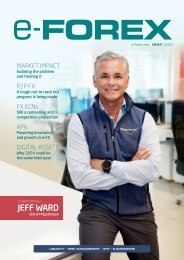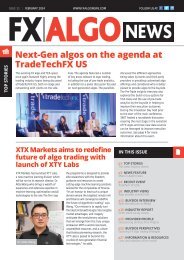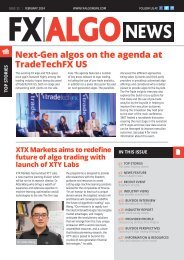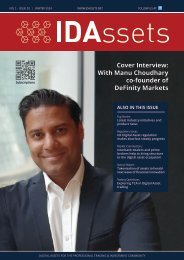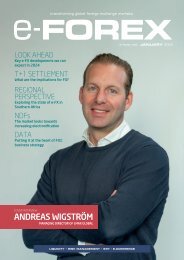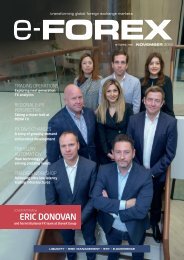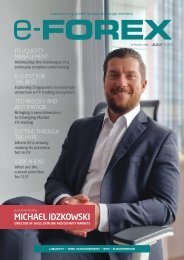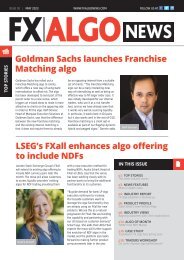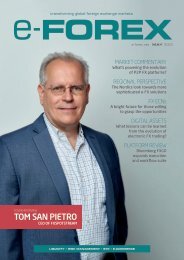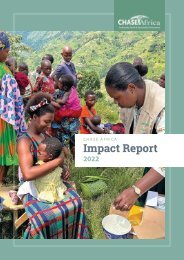e-Forex July 22
You also want an ePaper? Increase the reach of your titles
YUMPU automatically turns print PDFs into web optimized ePapers that Google loves.
Electronification and Automation: Unlocking the full potential of Emerging Market FX trading<br />
SPECIAL REPORT<br />
“Uncontrolled taking can rapidly ruin any good pool of<br />
liquidity. The volatile nature of EM trading makes it all<br />
the more important to ensure that takers and makers are<br />
matched off appropriately in a compatible way.”<br />
Clinton Norton<br />
liquidity is thin, takers want to rely on<br />
the expertise of the physical trader to<br />
get done with limited market impact<br />
and tighter spreads. Technology is<br />
increasingly allowing traders to supplant<br />
the manual process. At Euronext FX<br />
for example, where over 20% of our<br />
trading is emerging market, we provide<br />
a safe environment for niche currency<br />
players to offload risk undetected.”<br />
Other ways to achieve best execution<br />
through electronification is to utilise<br />
the same tools developed for the<br />
more liquid pairs and adapt them to<br />
the specificities of emerging market<br />
currency trading, says Norton.<br />
“Uncontrolled taking can rapidly<br />
ruin any good pool of liquidity. The<br />
volatile nature of EM trading makes<br />
it all the more important to ensure<br />
that takers and makers are matched<br />
off appropriately in a compatible<br />
way. Our liquidity management team<br />
at Euronext FX manages bespoke<br />
liquidity pools for each client based<br />
on trading needs and trading style.<br />
In a way, the manual intervention<br />
happens up stream, ahead of trading,<br />
and is informed by transparency,<br />
communication and data analysis.”<br />
Although remote niche LPs can<br />
supply very competitive prices,<br />
they often lack the tools to check<br />
and monitor the quality of takers<br />
to ensure they match their pricing<br />
model appropriately, says Norton.<br />
“Again, our LM team can step in<br />
to create, manage and monitor<br />
interactions in a systematic and<br />
automated way with a range of<br />
automated tools and analytics.”<br />
When it comes to maximising access<br />
to liquidity, FX platforms need to<br />
be connected to the best emerging<br />
market market-makers possible, says<br />
Norton. “They are typically not the<br />
traditional tier1 banks but rather the<br />
few tier 2 banks and local broker<br />
dealers that specialise in trading their<br />
specific set of currency pairs derived<br />
from natural local interest.”<br />
“Tight prices are derived from<br />
informed market-makers that<br />
have access to local markets and<br />
uncorrelated flow. FX platforms<br />
need to find a way to connect these<br />
sometimes remote liquidity providers<br />
and create a safe and easy access<br />
for makers and takers of emerging<br />
market liquidity to interact. This<br />
means finding these potential makers<br />
and then using technology to adapt<br />
to their needs that are typically<br />
unconventional,” says Norton. “Since<br />
these special makers often lack credit<br />
to the street and the capability to<br />
widely distribute their liquidity, they<br />
will rely on the FX platform partner<br />
for access and connectivity.”<br />
ELECTRONIC NDF MARKET<br />
In 2020 Euronext FX launched NDF<br />
trading out of Singapore, through<br />
the RMO license approved by the<br />
MAS and operated by Euronext<br />
Markets Singapore Pte Ltd. The<br />
electrification of the NDFs market is<br />
a natural extension of this trend, says<br />
Norton. “Technology has allowed for<br />
the faster and wider connectivity of<br />
makers and takers to the point where<br />
it is blurring the lines of conventional<br />
buy and sell side interactions. The<br />
proliferation of venues complying<br />
with the various interpretations of<br />
global regulations has increased<br />
access to NDF trading which is now<br />
reaching mainstream. Both liquidity<br />
providers and takers have had time<br />
to adjust to this peculiar market and<br />
now better understand the rules set<br />
by regulators such as Dodd Frank and<br />
MiFID around trading and reporting<br />
and are better able to decide on the<br />
best way to access NDF trading.<br />
While electronic platforms can help<br />
to reduce operational risks that are<br />
more pronounced in the EM universe,<br />
it is still important to tread carefully<br />
says Norton. “What works for G10<br />
currencies does not automatically<br />
transfer to EM where liquidity can<br />
be thin and markets volatile. It’s<br />
important to be able to adapt trading<br />
to the quickly changing environment<br />
of NDF trading. Our local liquidity<br />
management teams understand this,<br />
and use automated analytical tools<br />
that are quick to detect anomalies<br />
in the market that could impact our<br />
clients’ trading. Thinner liquidity and<br />
greater volatility in EM mean that<br />
traders should adhere to a stricter<br />
trading protocol than in G10 so as to<br />
not harm participants.”<br />
ELECTRONIC PRODUCT<br />
INNOVATION<br />
Electronic product innovation in the<br />
EM FX trading space is an ongoing<br />
process. For example, Euronext<br />
FX has introduced its ‘LSP 0’<br />
functionality (Leak Sweep Protection<br />
with 0 hold time) which performs the<br />
price check on behalf of the taker<br />
34 JULY 20<strong>22</strong> e-FOREX




